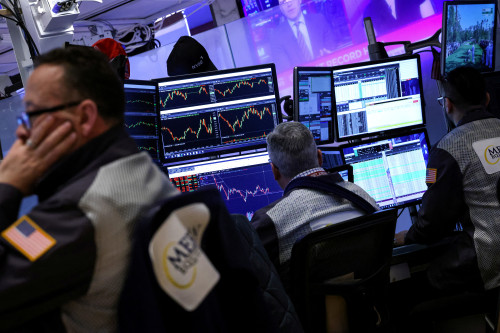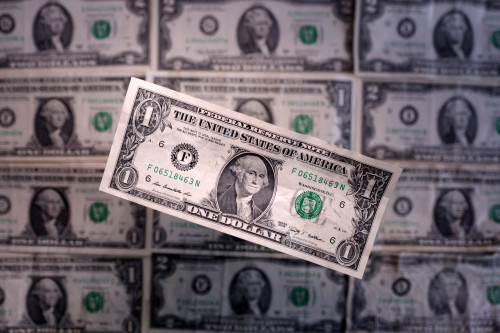
By Jamie McGeever
ORLANDO, Florida (Reuters) – TRADING DAY
Scorn in the USA
If there is one takeaway for investors above all others from yet another tumultuous week in world markets, it may be this: the safe-haven status of U.S. Treasuries and the dollar’s status as the world’s reserve currency are now in serious doubt.
There is a growing belief – indeed, fear – that the Trump administration’s economic, fiscal and political agenda is undermining the credibility and reliability of the U.S. financial system. Investors are voting with their feet.
“Dedollarization was nonsense for my entire life – until this past week,” as currency analyst Chris Vecchio succinctly puts it.
U.S. President Donald Trump’s tariffs and all-out trade war with China appeared to hammer another nail in the coffin of ‘U.S. exceptionalism’ this week as the dollar and U.S. bonds got crushed, stoking concern over the dislocation at the long end of the Treasury curve. Fed officials on Friday said they will act to keep markets functioning should the need arise.
Traditional ‘safe-haven’ assets like gold, the Japanese yen and Swiss franc rose significantly this week, as did the euro. This presents huge difficulties for the European Central Bank and Swiss National Bank – the last thing they want in a global trade war is a rapidly appreciating exchange rate.
China’s yuan is headed in the opposite direction. With its economy already wracked by a property sector bust, deflation, and weak demand, an all-out trade war with the U.S. has helped push the onshore and offshore yuan to historic lows.
Wall Street just notched its best week in years, but it would be disingenuous to take that at face value. The bounce was entirely due to the historic relief rally on Wednesday after Trump’s tariff climb-down, only half of the previous week’s losses were recovered, and the VIX volatility index is still roughly double its ‘normal’ level.
Visibility is virtually non-existent, so investors will be desperately seeking any scraps of guidance next week from the White House, Treasury or Fed. The U.S. earnings season is underway, but it will be a stretch to expect CEOs and CFOs to offer any clarity on the outlook.
I’d love to hear from you, so please reach out to me with comments at . You can also follow me at @ReutersJamie and @reutersjamie.bsky.social.
This Week’s Key Market Moves
* 30-year U.S. Treasury yield rises 47 basis points, itsbiggest weekly rise since April 1987. * 10-year Treasury yield surges 49 bps, its biggest risesince November 2001. * The S&P 500 rises 5.7% and the Nasdaq rebounds 7.3%, theirbest weeks since November 2023 and November 2022, respectively. * Dollar index falls 3% to its lowest in three years, as theeuro leaps 3.5% and the yen rises 2.4%. * The Swiss franc soars 5.5% against the dollar, one of itsbest weeks since the era of free-floating exchange rates beganover 50 years ago. * China’s offshore yuan hits a record low of 7.4287 perdollar before ending the week little changed, while the onshorespot yuan falls to 7.3518 per dollar, its weakest since December2007. * Gold rises 6.5% to a new high above $3,200/oz. It is up23% so far this year. * Oil ends the week only 1.3% lower, recovering ground onFriday after Brent crude futures hit a four-year low of$58.40/bbl earlier in the week. Oil is still down 25%year-on-year. * U.S. high-yield bond spread widens to 460 bps, the widestin nearly two years. * Chinese stocks fall 2.8%, Asian stocks ex-Japan fall 3.8%,and Japan’s Nikkei 225 ends the week just 0.6% lower. Theseclosing levels hide a lot of intra-week churn, especially inJapan.
Charts of the Week
Two charts for you today.
The first is what it looks like when the world starts questioning the wisdom of holding the dollar and U.S. Treasuries.
The second shows why the Fed is in a real bind. Although it may want to cut rates to mitigate the economic slowdown, its hands are tied – consumer inflation expectations this month surged to the highest since 1981.
Here are some of the best things I read this week:
1. Who Will Drive the Post-American Global Economy? – JimO’Neill 2. The Cost of Chaos: This is Getting Scary – Paul Krugman 3. Tariff turmoil in markets – Robin Brooks 4. Here’s one key thing you should know about Trump’s shockto the world economy: it could work – James Meadway 5. The Fiscal and Economic Effects of the Revised April 9Tariffs – Budget Lab at Yale
What could move markets on Monday?
* China trade (March) * India wholesale inflation (March) * Singapore GDP (Q1 flash estimate) * Richmond Fed President Thomas Barkin, Philadelphia FedPresident Patrick Harker and Atlanta Fed President RaphaelBostic speak at separate events
Opinions expressed are those of the author. They do not reflect the views of Reuters News, which, under the Trust Principles, is committed to integrity, independence, and freedom from bias.
Trading Day is also sent by email every weekday morning. Think your friend or colleague should know about us? Forward this newsletter to them. They can also sign up here.
(Writing by Jamie McGeever; Editing by Nia Williams)




